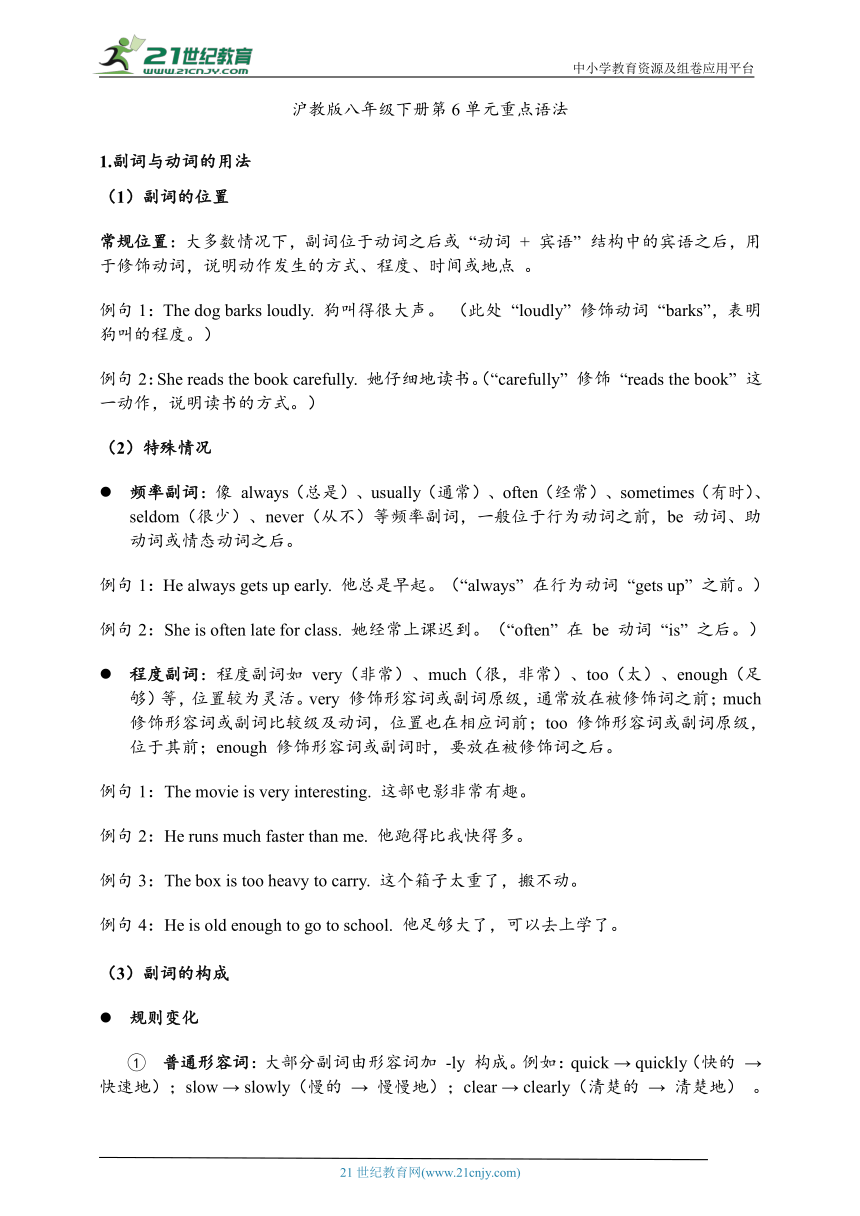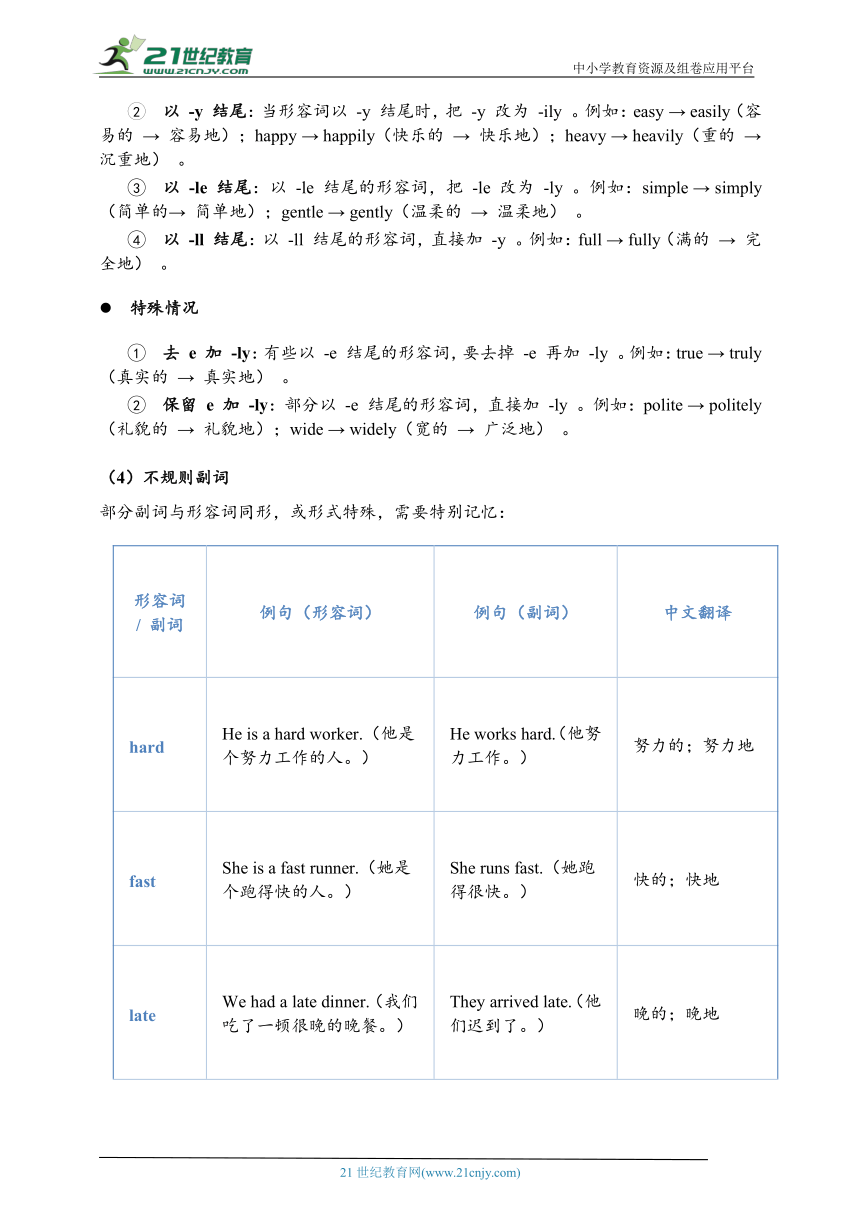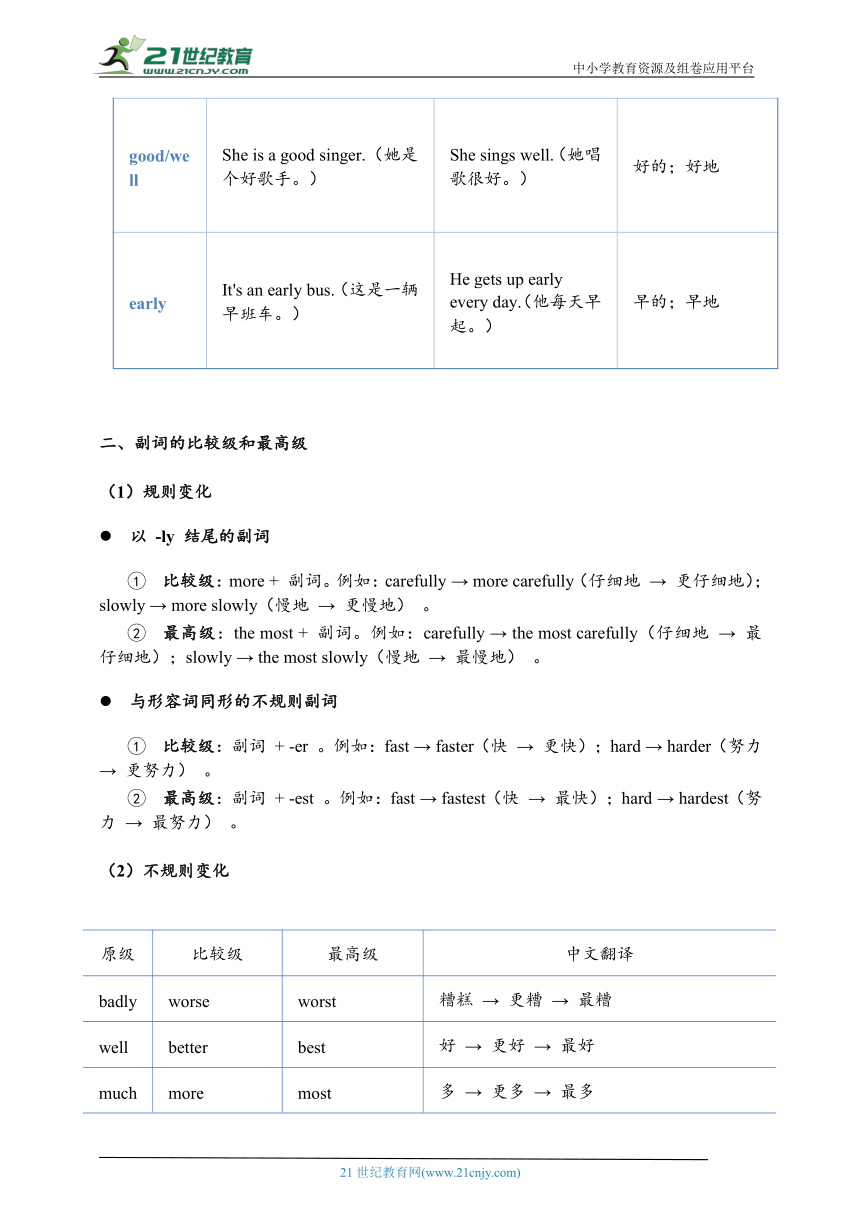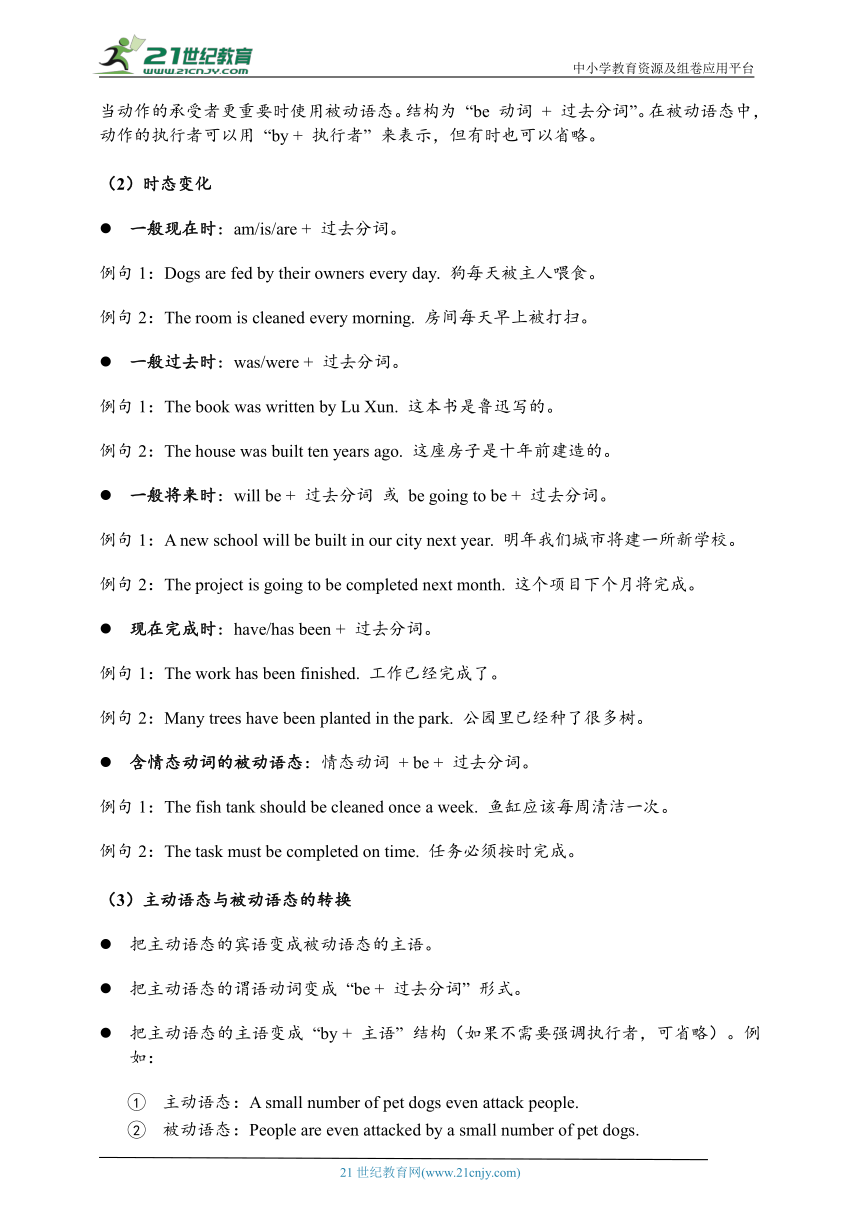沪教版八年级英语下册Unit 6 Pets 重点语法(学案)
文档属性
| 名称 | 沪教版八年级英语下册Unit 6 Pets 重点语法(学案) |  | |
| 格式 | doc | ||
| 文件大小 | 534.2KB | ||
| 资源类型 | 试卷 | ||
| 版本资源 | 牛津深圳版 | ||
| 科目 | 英语 | ||
| 更新时间 | 2025-04-29 19:26:11 | ||
图片预览





文档简介
中小学教育资源及组卷应用平台
沪教版八年级下册第6单元重点语法
1.副词与动词的用法
(1)副词的位置
常规位置:大多数情况下,副词位于动词之后或 “动词 + 宾语” 结构中的宾语之后,用于修饰动词,说明动作发生的方式、程度、时间或地点 。
例句1:The dog barks loudly. 狗叫得很大声。 (此处 “loudly” 修饰动词 “barks”,表明狗叫的程度。)
例句2:She reads the book carefully. 她仔细地读书。(“carefully” 修饰 “reads the book” 这一动作,说明读书的方式。)
(2)特殊情况
频率副词:像 always(总是)、usually(通常)、often(经常)、sometimes(有时)、seldom(很少)、never(从不)等频率副词,一般位于行为动词之前,be 动词、助动词或情态动词之后。
例句1:He always gets up early. 他总是早起。(“always” 在行为动词 “gets up” 之前。)
例句2:She is often late for class. 她经常上课迟到。(“often” 在 be 动词 “is” 之后。)
程度副词:程度副词如 very(非常)、much(很,非常)、too(太)、enough(足够)等,位置较为灵活。very 修饰形容词或副词原级,通常放在被修饰词之前;much 修饰形容词或副词比较级及动词,位置也在相应词前;too 修饰形容词或副词原级,位于其前;enough 修饰形容词或副词时,要放在被修饰词之后。
例句1:The movie is very interesting. 这部电影非常有趣。
例句2:He runs much faster than me. 他跑得比我快得多。
例句3:The box is too heavy to carry. 这个箱子太重了,搬不动。
例句4:He is old enough to go to school. 他足够大了,可以去上学了。
(3)副词的构成
规则变化
普通形容词:大部分副词由形容词加 -ly 构成。例如:quick → quickly(快的 → 快速地);slow → slowly(慢的 → 慢慢地);clear → clearly(清楚的 → 清楚地) 。
以 -y 结尾:当形容词以 -y 结尾时,把 -y 改为 -ily 。例如:easy → easily(容易的 → 容易地);happy → happily(快乐的 → 快乐地);heavy → heavily(重的 → 沉重地) 。
以 -le 结尾:以 -le 结尾的形容词,把 -le 改为 -ly 。例如:simple → simply(简单的→ 简单地);gentle → gently(温柔的 → 温柔地) 。
以 -ll 结尾:以 -ll 结尾的形容词,直接加 -y 。例如:full → fully(满的 → 完全地) 。
特殊情况
去 e 加 -ly:有些以 -e 结尾的形容词,要去掉 -e 再加 -ly 。例如:true → truly(真实的 → 真实地) 。
保留 e 加 -ly:部分以 -e 结尾的形容词,直接加 -ly 。例如:polite → politely(礼貌的 → 礼貌地);wide → widely(宽的 → 广泛地) 。
(4)不规则副词
部分副词与形容词同形,或形式特殊,需要特别记忆:
形容词 / 副词 例句(形容词) 例句(副词) 中文翻译
hard He is a hard worker.(他是个努力工作的人。) He works hard.(他努力工作。) 努力的;努力地
fast She is a fast runner.(她是个跑得快的人。) She runs fast.(她跑得很快。) 快的;快地
late We had a late dinner.(我们吃了一顿很晚的晚餐。) They arrived late.(他们迟到了。) 晚的;晚地
good/well She is a good singer.(她是个好歌手。) She sings well.(她唱歌很好。) 好的;好地
early It's an early bus.(这是一辆早班车。) He gets up early every day.(他每天早起。) 早的;早地
二、副词的比较级和最高级
(1)规则变化
以 -ly 结尾的副词
比较级:more + 副词。例如:carefully → more carefully(仔细地 → 更仔细地);slowly → more slowly(慢地 → 更慢地) 。
最高级:the most + 副词。例如:carefully → the most carefully(仔细地 → 最仔细地);slowly → the most slowly(慢地 → 最慢地) 。
与形容词同形的不规则副词
比较级:副词 + -er 。例如:fast → faster(快 → 更快);hard → harder(努力 → 更努力) 。
最高级:副词 + -est 。例如:fast → fastest(快 → 最快);hard → hardest(努力 → 最努力) 。
(2)不规则变化
原级 比较级 最高级 中文翻译
badly worse worst 糟糕 → 更糟 → 最糟
well better best 好 → 更好 → 最好
much more most 多 → 更多 → 最多
little less least 少 → 更少 → 最少
far farther/further farthest/furthest 远 → 更远 → 最远;进一步 → 更进一步 → 最深入
(3)特殊用法
两者比较:使用 than 来连接比较对象。例如:
例句1:Dogs need to be trained more patiently than cats. 狗需要比猫更有耐心地训练。
例句2:She runs faster than her brother. 她跑得比她哥哥快。
三者及以上比较:使用 the most 或 the -est 来表示最高程度。例如:
例句1:Ken’s helpers care the least about pets. 肯的助手对宠物的关心最少。
例句2:Among all the students, Tom studies the hardest. 在所有学生中,汤姆学习最努力。
三、情态动词 “had better” 的用法
(1)基本结构与含义
表示建议、警告或强烈推荐,常用于口语,暗示如果不这样做可能会有负面后果。结构为:主语 + had better (+ not) + 动词原形 。
例句1:You’d better put more water in the fish tank, Lo. 你最好往鱼缸里多加点水,老罗。
例句2:You had better take an umbrella. It’s going to rain. 你最好带把伞,快下雨了。
例句3:She’d better not be late for the meeting. 她最好不要开会迟到。
(2)使用注意事项
“had better” 没有人称、数和时态的变化,无论主语是第几人称,都用 “had better” 形式 。
其否定形式是在 “better” 后直接加 “not”,而不是在 “had” 后加 “not” 。
四、被动语态
(1)基本概念
当动作的承受者更重要时使用被动语态。结构为 “be 动词 + 过去分词”。在被动语态中,动作的执行者可以用 “by + 执行者” 来表示,但有时也可以省略。
(2)时态变化
一般现在时:am/is/are + 过去分词。
例句1:Dogs are fed by their owners every day. 狗每天被主人喂食。
例句2:The room is cleaned every morning. 房间每天早上被打扫。
一般过去时:was/were + 过去分词。
例句1:The book was written by Lu Xun. 这本书是鲁迅写的。
例句2:The house was built ten years ago. 这座房子是十年前建造的。
一般将来时:will be + 过去分词 或 be going to be + 过去分词。
例句1:A new school will be built in our city next year. 明年我们城市将建一所新学校。
例句2:The project is going to be completed next month. 这个项目下个月将完成。
现在完成时:have/has been + 过去分词。
例句1:The work has been finished. 工作已经完成了。
例句2:Many trees have been planted in the park. 公园里已经种了很多树。
含情态动词的被动语态:情态动词 + be + 过去分词。
例句1:The fish tank should be cleaned once a week. 鱼缸应该每周清洁一次。
例句2:The task must be completed on time. 任务必须按时完成。
(3)主动语态与被动语态的转换
把主动语态的宾语变成被动语态的主语。
把主动语态的谓语动词变成 “be + 过去分词” 形式。
把主动语态的主语变成 “by + 主语” 结构(如果不需要强调执行者,可省略)。例如:
主动语态:A small number of pet dogs even attack people.
被动语态:People are even attacked by a small number of pet dogs.
五、条件句
(1)真实条件句(第一类条件句)
结构:If + 一般现在时,主句用一般将来时 / 情态动词 。
含义:表示在一定条件下,某事很可能发生,是真实的或有很大可能性的情况。
例句1:If you keep a dog, you need to walk it every day. 如果你养狗,你需要每天遛它。
例句2:If you don’t feed the cat, it will be hungry. 如果你不喂猫,它会饿的。
例句3:If it rains tomorrow, we can stay at home. 如果明天下雨,我们可以待在家里。
(2)虚拟条件句(第二类条件句)
结构:If + 一般过去时,主句用 would/could/might + 动词原形 。
含义:表示与现在事实相反的假设,或不太可能实现的情况 。
例句1:If I had a garden, I would keep a dog. 如果我有花园,我会养一只狗。(实际上现在没有花园。)
例句2:If I were you, I would study harder. 如果我是你,我会更努力学习。(“我” 不可能是 “你”,这是与事实相反的假设。)
例句3:If she knew the answer, she could tell us. 如果她知道答案,她就能告诉我们。(但实际上她不知道答案。)
(3)第三类条件句(与过去事实相反的虚拟条件句)
结构:If + 过去完成时,主句用 would/could/might + have + 过去分词 。
含义:表示与过去事实相反的假设,即过去没有发生的事情,如果当时发生了会有怎样的结果 。例如:
例句1:If you had studied harder, you would have passed the exam. 如果你当时更努力学习,你就会通过考试了。(但实际上过去没有努力学习,也没有通过考试。)
例句2:If it had not rained yesterday, we could have gone for a picnic. 如果昨天下雨,我们就可以去野餐了。(但昨天实际上下雨了,没有去野餐。)
六、连接词
(1)表示顺序
Firstly, Secondly, Finally:常用于列举多个观点或步骤,使文章条理清晰 。
例句1:First, dogs are really cute. Second, we can learn responsibility. Finally, dogs will love you faithfully.
例句2:Firstly, turn on the computer. Secondly, open the relevant software. Finally, start working on your project.
其他表示顺序的连接词:besides(此外)、in addition(另外)、next(接下来)、then(然后)等 。
例句1:We need to buy some food. Besides, we should also get some drinks.
例句2:First, mix the flour and water. Next, add some sugar and eggs. Then, bake the mixture in the oven.
(2)表示因果关系
Because, Therefore, As a result:用于表达事物之间的因果联系 。
例句1:Dogs bark loudly, so they can protect your home. 狗叫得很大声,因此它们能保护你的家。
例句2:He didn’t study hard. Therefore, he failed the exam. 他学习不努力。因此,他考试不及格。
例句3:It rained heavily. As a result, the streets were flooded. 雨下得很大。结果,街道被淹了。
其他表示因果关系的连接词:since(既然,因为)、as(因为)、due to(由于)、owing to(因为)等 。
例句1:Since you are here, you can help me with this work.
例句2:As it was late, we decided to go home.
例句3:Due to the bad weather, the flight was cancelled.
(3)表示转折关系
but(但是)、however(然而)、although/though(虽然,尽管)、yet(但是,然而)等 。
例句1:He is very rich but not happy.
例句2:She worked hard. However, she still didn’t get the promotion.
例句3:Although/Though it was raining heavily, he still went out.
例句4:He is old, yet he is very energetic.
(4)表示并列关系
and(和,并且)、or(或者)、both...and...(两者都)、not only...but also...(不仅…… 而且……)、either...or...(要么…… 要么……)等 。例如:
例句1:I like reading and writing.
例句2:You can choose the red one or the blue one.
例句3:Both Tom and Jerry like playing football.
例句4:She is not only good at singing but also excellent at dancing.
例句5:Either you come to my place or I go to yours.
七、疑问句结构
(1)一般疑问句
结构:助动词 + 主语 + 动词原形?助动词包括 be 动词(am/is/are/was/were)、情态动词(can/could/may/might/must/should 等)和助动词(do/does/did) 。例如:
例句1:Do you have a pet 你有宠物吗?
例句2:Can dogs feel unhappy 狗会感到不开心吗?
例句3:Is she a teacher 她是老师吗?
例句4:Did you go to the park yesterday 你昨天去公园了吗?
回答方式:一般用 Yes 或 No 来回答。例如:
例句1:—Do you like apples
—Yes, I do./No, I don’t.
例句2:—Can he swim
—Yes, he can./No, he can’t.
(2)特殊疑问句
结构:疑问词 + 助动词 + 主语 + 动词原形?疑问词包括 what(什么)、who(谁)、where(哪里)、when(什么时候)、why(为什么)、how(如何)等 。
例句1:Why do people keep pets (人们为什么养宠物?)
例句2:What do you think the article is about (你认为这篇文章是关于什么的?)
例句3:Where did you go last weekend (你上周末去哪里了?)
例句4:How can I get to the station (我怎么才能到车站?)
回答方式:根据具体的疑问词和问题内容进行详细回答,而不是简单的 Yes 或 No 。
例句1:—What do you do on Sundays
—I usually read books and watch TV.
例句2:—Where is your school
—It’s near the park.
(3)选择疑问句
结构:一般疑问句 + or + 另一个选择项? 或者特殊疑问句 + A or B?例如:
例句1:Do you like tea or coffee 你喜欢茶还是咖啡?
例句2:Is he a doctor or a teacher 他是医生还是老师?
例句3:Which do you prefer, the red one or the blue one 你更喜欢哪一个,红色的还是蓝色的?
回答方式:不能用 Yes 或 No 回答,需要从提供的选项中选择一个进行回答,或者根据实际情况给出具体答案 。
例句1:—Do you want to go by bus or by train
—By train.
例句2:—Which is bigger, the sun or the moon
—The sun.
八、直接引语与间接引语
(1)直接引语转间接引语
直接引语是直接引用说话者的原话,而间接引语是转述他人的话。将直接引语转换为间接引语时,需要注意人称、时态、时间状语、地点状语等的变化。
人称变化:一般遵循 “一随主,二随宾,三不变” 的原则。即直接引语中的第一人称,变间接引语时与主句的主语保持一致;第二人称与主句的宾语保持一致;第三人称不变。
如:
直接引语:She said, “I like this book.”
间接引语:She said that she liked that book.
直接引语:He said to me, “You are right.”
间接引语:He told me that I was right.
直接引语:They said, “They will go there tomorrow.”
间接引语:They said that they would go there the next day.
时态变化:如果主句的谓语动词是一般过去时,直接引语变为间接引语时,从句的时态通常要向后推移。具体变化规则如下:
直接引语时态 间接引语时态 例句(直接引语) 示例句(间接引语)
一般现在时 一般过去时 “I play football every day,” Tom said. Tom said that he played football every day.
现在进行时 过去进行时 “She is reading a book,” Lucy said. Lucy said that she was reading a book.
现在完成时 过去完成时 “They have finished the work,” John said. John said that they had finished the work.
一般过去时 过去完成时 “He went to the park yesterday,” Mary said. Mary said that he had gone to the park the day before.
过去进行时 过去完成进行时 “We were watching TV at that time,” they said. They said that they had been watching TV at that time.
一般将来时 过去将来时 “I will go to Beijing next week,” she said. She said that she would go to Beijing the next week.
但如果直接引语表达的是客观真理、普遍事实或习惯性动作,时态不变。如:
直接引语:The teacher said, “The earth moves around the sun.”
间接引语:The teacher said that the earth moves around the sun.
时间状语和地点状语变化:
直接引语 间接引语
now then
today that day
yesterday the day before
tomorrow the next/following day
last week/month/year the week/month/year before
next week/month/year the next/following week/month/year
here there
如:
直接引语:He said, “I will come here tomorrow.”
间接引语:He said that he would go there the next day.
(2)疑问句和祈使句的转换
一般疑问句:直接引语如果是一般疑问句,变为间接引语时,要用陈述语序,并在间接引语前加上 if 或 whether。
如:
直接引语:He asked, “Is it raining ”
间接引语:He asked if/whether it was raining.
特殊疑问句:直接引语如果是特殊疑问句,变为间接引语时,仍用原来的疑问词引导,但要把疑问语序变为陈述语序。
如:
直接引语:She asked, “Where are you going ”
间接引语:She asked where I was going.
祈使句:直接引语如果是祈使句,变为间接引语时,要将祈使句的动词原形变为带 to 的不定式,并根据句子语气在不定式前加上 tell, ask, order 等动词。如果祈使句为否定式,在不定式前加 not。
如:
直接引语:The teacher said to the students, “Be quiet.”
间接引语:The teacher told the students to be quiet.
直接引语:He said to me, “Don’t open the window.”
间接引语:He told me not to open the window.
九、名词性从句
名词性从句包括主语从句、宾语从句、表语从句和同位语从句,在句子中起名词的作用,可以作主语、宾语、表语和同位语。
(1)宾语从句
结构:主句 + 连接词 + 从句(从句用陈述语序)。常用的连接词有 that(在从句中不充当成分,口语中可省略)、if/whether(表示 “是否”,在从句中不充当成分)、疑问词(what, who, whom, whose, which, when, where, why, how 等,在从句中充当成分)。
例句1:I know (that) he is a good student.(that 可省略)
例句2:She asked if/whether I liked music.
例句3:Do you know what he is doing
时态一致:如果主句的时态是一般现在时或一般将来时,宾语从句的时态可以根据实际情况而定;如果主句的时态是一般过去时,宾语从句通常要用相应的过去时态。
例句1:He says that he will go to the park tomorrow.(主句一般现在时,从句根据实际用一般将来时)
例句2:He said that he would go to the park the next day.(主句一般过去时,从句用过去将来时)
但如果宾语从句表达的是客观真理、普遍事实或习惯性动作,时态不变。例如
例句3:The teacher told us that the sun rises in the east.
(2)表语从句
结构:主语 + be 动词 + 连接词 + 从句(从句用陈述语序)。常用的连接词有 that(在从句中不充当成分,但不能省略)、whether(表示 “是否”,在从句中不充当成分)、疑问词(what, who, whom, whose, which, when, where, why, how 等,在从句中充当成分)、as if/as though(表示 “好像”,在从句中不充当成分)等。
例句1:The fact is that he didn’t tell the truth.
例句2:The question is whether we can finish the work on time.
例句3:This is where I lived ten years ago.
例句4:It looks as if it is going to rain.
作用:表语从句的作用是对主语进行解释说明,使主语的内容更加具体明确。
(3)主语从句
结构:连接词 + 从句 + 谓语 + 其他成分 或 It + 谓语 + 连接词 + 从句(it 作形式主语,真正的主语是后面的从句)。常用的连接词与宾语从句和表语从句类似。
例句1:That he is a good student is known to us all.(正常语序)
例句2:It is known to us all that he is a good student.(it 作形式主语)
例句3:Whether he will come or not is still unknown.
例句4:What he said made me angry.
注意事项:当主语从句作主语时,谓语动词一般用单数形式;为了避免句子头重脚轻,常用 it 作形式主语,而把真正的主语从句放在句末。
(4)同位语从句
结构:名词 + 连接词 + 从句(从句用陈述语序)。同位语从句通常跟在某些抽象名词(如 idea, fact, news, hope, thought, suggestion, advice, order 等)后面,对前面的名词进行解释说明。常用的连接词有 that(在从句中不充当成分,但不能省略)、whether(表示 “是否”,在从句中不充当成分)、疑问词(what, who, whom, whose, which, when, where, why, how 等,在从句中充当成分)等。
例句1:The news that our team won the game is true.
例句2:I have no idea whether he will come or not.
例句3:The question how we can get there is still under discussion.
与定语从句的区别:同位语从句是对前面名词的内容进行解释说明,从句与名词是等同关系;而定语从句是对前面名词进行修饰限定,从句与名词是所属关系。同位语从句中的 that 不充当成分,只起连接作用,且不能省略;定语从句中的 that 在从句中充当主语或宾语,作宾语时可以省略。
21世纪教育网 www.21cnjy.com 精品试卷·第 2 页 (共 2 页)
HYPERLINK "http://21世纪教育网(www.21cnjy.com)
" 21世纪教育网(www.21cnjy.com)
沪教版八年级下册第6单元重点语法
1.副词与动词的用法
(1)副词的位置
常规位置:大多数情况下,副词位于动词之后或 “动词 + 宾语” 结构中的宾语之后,用于修饰动词,说明动作发生的方式、程度、时间或地点 。
例句1:The dog barks loudly. 狗叫得很大声。 (此处 “loudly” 修饰动词 “barks”,表明狗叫的程度。)
例句2:She reads the book carefully. 她仔细地读书。(“carefully” 修饰 “reads the book” 这一动作,说明读书的方式。)
(2)特殊情况
频率副词:像 always(总是)、usually(通常)、often(经常)、sometimes(有时)、seldom(很少)、never(从不)等频率副词,一般位于行为动词之前,be 动词、助动词或情态动词之后。
例句1:He always gets up early. 他总是早起。(“always” 在行为动词 “gets up” 之前。)
例句2:She is often late for class. 她经常上课迟到。(“often” 在 be 动词 “is” 之后。)
程度副词:程度副词如 very(非常)、much(很,非常)、too(太)、enough(足够)等,位置较为灵活。very 修饰形容词或副词原级,通常放在被修饰词之前;much 修饰形容词或副词比较级及动词,位置也在相应词前;too 修饰形容词或副词原级,位于其前;enough 修饰形容词或副词时,要放在被修饰词之后。
例句1:The movie is very interesting. 这部电影非常有趣。
例句2:He runs much faster than me. 他跑得比我快得多。
例句3:The box is too heavy to carry. 这个箱子太重了,搬不动。
例句4:He is old enough to go to school. 他足够大了,可以去上学了。
(3)副词的构成
规则变化
普通形容词:大部分副词由形容词加 -ly 构成。例如:quick → quickly(快的 → 快速地);slow → slowly(慢的 → 慢慢地);clear → clearly(清楚的 → 清楚地) 。
以 -y 结尾:当形容词以 -y 结尾时,把 -y 改为 -ily 。例如:easy → easily(容易的 → 容易地);happy → happily(快乐的 → 快乐地);heavy → heavily(重的 → 沉重地) 。
以 -le 结尾:以 -le 结尾的形容词,把 -le 改为 -ly 。例如:simple → simply(简单的→ 简单地);gentle → gently(温柔的 → 温柔地) 。
以 -ll 结尾:以 -ll 结尾的形容词,直接加 -y 。例如:full → fully(满的 → 完全地) 。
特殊情况
去 e 加 -ly:有些以 -e 结尾的形容词,要去掉 -e 再加 -ly 。例如:true → truly(真实的 → 真实地) 。
保留 e 加 -ly:部分以 -e 结尾的形容词,直接加 -ly 。例如:polite → politely(礼貌的 → 礼貌地);wide → widely(宽的 → 广泛地) 。
(4)不规则副词
部分副词与形容词同形,或形式特殊,需要特别记忆:
形容词 / 副词 例句(形容词) 例句(副词) 中文翻译
hard He is a hard worker.(他是个努力工作的人。) He works hard.(他努力工作。) 努力的;努力地
fast She is a fast runner.(她是个跑得快的人。) She runs fast.(她跑得很快。) 快的;快地
late We had a late dinner.(我们吃了一顿很晚的晚餐。) They arrived late.(他们迟到了。) 晚的;晚地
good/well She is a good singer.(她是个好歌手。) She sings well.(她唱歌很好。) 好的;好地
early It's an early bus.(这是一辆早班车。) He gets up early every day.(他每天早起。) 早的;早地
二、副词的比较级和最高级
(1)规则变化
以 -ly 结尾的副词
比较级:more + 副词。例如:carefully → more carefully(仔细地 → 更仔细地);slowly → more slowly(慢地 → 更慢地) 。
最高级:the most + 副词。例如:carefully → the most carefully(仔细地 → 最仔细地);slowly → the most slowly(慢地 → 最慢地) 。
与形容词同形的不规则副词
比较级:副词 + -er 。例如:fast → faster(快 → 更快);hard → harder(努力 → 更努力) 。
最高级:副词 + -est 。例如:fast → fastest(快 → 最快);hard → hardest(努力 → 最努力) 。
(2)不规则变化
原级 比较级 最高级 中文翻译
badly worse worst 糟糕 → 更糟 → 最糟
well better best 好 → 更好 → 最好
much more most 多 → 更多 → 最多
little less least 少 → 更少 → 最少
far farther/further farthest/furthest 远 → 更远 → 最远;进一步 → 更进一步 → 最深入
(3)特殊用法
两者比较:使用 than 来连接比较对象。例如:
例句1:Dogs need to be trained more patiently than cats. 狗需要比猫更有耐心地训练。
例句2:She runs faster than her brother. 她跑得比她哥哥快。
三者及以上比较:使用 the most 或 the -est 来表示最高程度。例如:
例句1:Ken’s helpers care the least about pets. 肯的助手对宠物的关心最少。
例句2:Among all the students, Tom studies the hardest. 在所有学生中,汤姆学习最努力。
三、情态动词 “had better” 的用法
(1)基本结构与含义
表示建议、警告或强烈推荐,常用于口语,暗示如果不这样做可能会有负面后果。结构为:主语 + had better (+ not) + 动词原形 。
例句1:You’d better put more water in the fish tank, Lo. 你最好往鱼缸里多加点水,老罗。
例句2:You had better take an umbrella. It’s going to rain. 你最好带把伞,快下雨了。
例句3:She’d better not be late for the meeting. 她最好不要开会迟到。
(2)使用注意事项
“had better” 没有人称、数和时态的变化,无论主语是第几人称,都用 “had better” 形式 。
其否定形式是在 “better” 后直接加 “not”,而不是在 “had” 后加 “not” 。
四、被动语态
(1)基本概念
当动作的承受者更重要时使用被动语态。结构为 “be 动词 + 过去分词”。在被动语态中,动作的执行者可以用 “by + 执行者” 来表示,但有时也可以省略。
(2)时态变化
一般现在时:am/is/are + 过去分词。
例句1:Dogs are fed by their owners every day. 狗每天被主人喂食。
例句2:The room is cleaned every morning. 房间每天早上被打扫。
一般过去时:was/were + 过去分词。
例句1:The book was written by Lu Xun. 这本书是鲁迅写的。
例句2:The house was built ten years ago. 这座房子是十年前建造的。
一般将来时:will be + 过去分词 或 be going to be + 过去分词。
例句1:A new school will be built in our city next year. 明年我们城市将建一所新学校。
例句2:The project is going to be completed next month. 这个项目下个月将完成。
现在完成时:have/has been + 过去分词。
例句1:The work has been finished. 工作已经完成了。
例句2:Many trees have been planted in the park. 公园里已经种了很多树。
含情态动词的被动语态:情态动词 + be + 过去分词。
例句1:The fish tank should be cleaned once a week. 鱼缸应该每周清洁一次。
例句2:The task must be completed on time. 任务必须按时完成。
(3)主动语态与被动语态的转换
把主动语态的宾语变成被动语态的主语。
把主动语态的谓语动词变成 “be + 过去分词” 形式。
把主动语态的主语变成 “by + 主语” 结构(如果不需要强调执行者,可省略)。例如:
主动语态:A small number of pet dogs even attack people.
被动语态:People are even attacked by a small number of pet dogs.
五、条件句
(1)真实条件句(第一类条件句)
结构:If + 一般现在时,主句用一般将来时 / 情态动词 。
含义:表示在一定条件下,某事很可能发生,是真实的或有很大可能性的情况。
例句1:If you keep a dog, you need to walk it every day. 如果你养狗,你需要每天遛它。
例句2:If you don’t feed the cat, it will be hungry. 如果你不喂猫,它会饿的。
例句3:If it rains tomorrow, we can stay at home. 如果明天下雨,我们可以待在家里。
(2)虚拟条件句(第二类条件句)
结构:If + 一般过去时,主句用 would/could/might + 动词原形 。
含义:表示与现在事实相反的假设,或不太可能实现的情况 。
例句1:If I had a garden, I would keep a dog. 如果我有花园,我会养一只狗。(实际上现在没有花园。)
例句2:If I were you, I would study harder. 如果我是你,我会更努力学习。(“我” 不可能是 “你”,这是与事实相反的假设。)
例句3:If she knew the answer, she could tell us. 如果她知道答案,她就能告诉我们。(但实际上她不知道答案。)
(3)第三类条件句(与过去事实相反的虚拟条件句)
结构:If + 过去完成时,主句用 would/could/might + have + 过去分词 。
含义:表示与过去事实相反的假设,即过去没有发生的事情,如果当时发生了会有怎样的结果 。例如:
例句1:If you had studied harder, you would have passed the exam. 如果你当时更努力学习,你就会通过考试了。(但实际上过去没有努力学习,也没有通过考试。)
例句2:If it had not rained yesterday, we could have gone for a picnic. 如果昨天下雨,我们就可以去野餐了。(但昨天实际上下雨了,没有去野餐。)
六、连接词
(1)表示顺序
Firstly, Secondly, Finally:常用于列举多个观点或步骤,使文章条理清晰 。
例句1:First, dogs are really cute. Second, we can learn responsibility. Finally, dogs will love you faithfully.
例句2:Firstly, turn on the computer. Secondly, open the relevant software. Finally, start working on your project.
其他表示顺序的连接词:besides(此外)、in addition(另外)、next(接下来)、then(然后)等 。
例句1:We need to buy some food. Besides, we should also get some drinks.
例句2:First, mix the flour and water. Next, add some sugar and eggs. Then, bake the mixture in the oven.
(2)表示因果关系
Because, Therefore, As a result:用于表达事物之间的因果联系 。
例句1:Dogs bark loudly, so they can protect your home. 狗叫得很大声,因此它们能保护你的家。
例句2:He didn’t study hard. Therefore, he failed the exam. 他学习不努力。因此,他考试不及格。
例句3:It rained heavily. As a result, the streets were flooded. 雨下得很大。结果,街道被淹了。
其他表示因果关系的连接词:since(既然,因为)、as(因为)、due to(由于)、owing to(因为)等 。
例句1:Since you are here, you can help me with this work.
例句2:As it was late, we decided to go home.
例句3:Due to the bad weather, the flight was cancelled.
(3)表示转折关系
but(但是)、however(然而)、although/though(虽然,尽管)、yet(但是,然而)等 。
例句1:He is very rich but not happy.
例句2:She worked hard. However, she still didn’t get the promotion.
例句3:Although/Though it was raining heavily, he still went out.
例句4:He is old, yet he is very energetic.
(4)表示并列关系
and(和,并且)、or(或者)、both...and...(两者都)、not only...but also...(不仅…… 而且……)、either...or...(要么…… 要么……)等 。例如:
例句1:I like reading and writing.
例句2:You can choose the red one or the blue one.
例句3:Both Tom and Jerry like playing football.
例句4:She is not only good at singing but also excellent at dancing.
例句5:Either you come to my place or I go to yours.
七、疑问句结构
(1)一般疑问句
结构:助动词 + 主语 + 动词原形?助动词包括 be 动词(am/is/are/was/were)、情态动词(can/could/may/might/must/should 等)和助动词(do/does/did) 。例如:
例句1:Do you have a pet 你有宠物吗?
例句2:Can dogs feel unhappy 狗会感到不开心吗?
例句3:Is she a teacher 她是老师吗?
例句4:Did you go to the park yesterday 你昨天去公园了吗?
回答方式:一般用 Yes 或 No 来回答。例如:
例句1:—Do you like apples
—Yes, I do./No, I don’t.
例句2:—Can he swim
—Yes, he can./No, he can’t.
(2)特殊疑问句
结构:疑问词 + 助动词 + 主语 + 动词原形?疑问词包括 what(什么)、who(谁)、where(哪里)、when(什么时候)、why(为什么)、how(如何)等 。
例句1:Why do people keep pets (人们为什么养宠物?)
例句2:What do you think the article is about (你认为这篇文章是关于什么的?)
例句3:Where did you go last weekend (你上周末去哪里了?)
例句4:How can I get to the station (我怎么才能到车站?)
回答方式:根据具体的疑问词和问题内容进行详细回答,而不是简单的 Yes 或 No 。
例句1:—What do you do on Sundays
—I usually read books and watch TV.
例句2:—Where is your school
—It’s near the park.
(3)选择疑问句
结构:一般疑问句 + or + 另一个选择项? 或者特殊疑问句 + A or B?例如:
例句1:Do you like tea or coffee 你喜欢茶还是咖啡?
例句2:Is he a doctor or a teacher 他是医生还是老师?
例句3:Which do you prefer, the red one or the blue one 你更喜欢哪一个,红色的还是蓝色的?
回答方式:不能用 Yes 或 No 回答,需要从提供的选项中选择一个进行回答,或者根据实际情况给出具体答案 。
例句1:—Do you want to go by bus or by train
—By train.
例句2:—Which is bigger, the sun or the moon
—The sun.
八、直接引语与间接引语
(1)直接引语转间接引语
直接引语是直接引用说话者的原话,而间接引语是转述他人的话。将直接引语转换为间接引语时,需要注意人称、时态、时间状语、地点状语等的变化。
人称变化:一般遵循 “一随主,二随宾,三不变” 的原则。即直接引语中的第一人称,变间接引语时与主句的主语保持一致;第二人称与主句的宾语保持一致;第三人称不变。
如:
直接引语:She said, “I like this book.”
间接引语:She said that she liked that book.
直接引语:He said to me, “You are right.”
间接引语:He told me that I was right.
直接引语:They said, “They will go there tomorrow.”
间接引语:They said that they would go there the next day.
时态变化:如果主句的谓语动词是一般过去时,直接引语变为间接引语时,从句的时态通常要向后推移。具体变化规则如下:
直接引语时态 间接引语时态 例句(直接引语) 示例句(间接引语)
一般现在时 一般过去时 “I play football every day,” Tom said. Tom said that he played football every day.
现在进行时 过去进行时 “She is reading a book,” Lucy said. Lucy said that she was reading a book.
现在完成时 过去完成时 “They have finished the work,” John said. John said that they had finished the work.
一般过去时 过去完成时 “He went to the park yesterday,” Mary said. Mary said that he had gone to the park the day before.
过去进行时 过去完成进行时 “We were watching TV at that time,” they said. They said that they had been watching TV at that time.
一般将来时 过去将来时 “I will go to Beijing next week,” she said. She said that she would go to Beijing the next week.
但如果直接引语表达的是客观真理、普遍事实或习惯性动作,时态不变。如:
直接引语:The teacher said, “The earth moves around the sun.”
间接引语:The teacher said that the earth moves around the sun.
时间状语和地点状语变化:
直接引语 间接引语
now then
today that day
yesterday the day before
tomorrow the next/following day
last week/month/year the week/month/year before
next week/month/year the next/following week/month/year
here there
如:
直接引语:He said, “I will come here tomorrow.”
间接引语:He said that he would go there the next day.
(2)疑问句和祈使句的转换
一般疑问句:直接引语如果是一般疑问句,变为间接引语时,要用陈述语序,并在间接引语前加上 if 或 whether。
如:
直接引语:He asked, “Is it raining ”
间接引语:He asked if/whether it was raining.
特殊疑问句:直接引语如果是特殊疑问句,变为间接引语时,仍用原来的疑问词引导,但要把疑问语序变为陈述语序。
如:
直接引语:She asked, “Where are you going ”
间接引语:She asked where I was going.
祈使句:直接引语如果是祈使句,变为间接引语时,要将祈使句的动词原形变为带 to 的不定式,并根据句子语气在不定式前加上 tell, ask, order 等动词。如果祈使句为否定式,在不定式前加 not。
如:
直接引语:The teacher said to the students, “Be quiet.”
间接引语:The teacher told the students to be quiet.
直接引语:He said to me, “Don’t open the window.”
间接引语:He told me not to open the window.
九、名词性从句
名词性从句包括主语从句、宾语从句、表语从句和同位语从句,在句子中起名词的作用,可以作主语、宾语、表语和同位语。
(1)宾语从句
结构:主句 + 连接词 + 从句(从句用陈述语序)。常用的连接词有 that(在从句中不充当成分,口语中可省略)、if/whether(表示 “是否”,在从句中不充当成分)、疑问词(what, who, whom, whose, which, when, where, why, how 等,在从句中充当成分)。
例句1:I know (that) he is a good student.(that 可省略)
例句2:She asked if/whether I liked music.
例句3:Do you know what he is doing
时态一致:如果主句的时态是一般现在时或一般将来时,宾语从句的时态可以根据实际情况而定;如果主句的时态是一般过去时,宾语从句通常要用相应的过去时态。
例句1:He says that he will go to the park tomorrow.(主句一般现在时,从句根据实际用一般将来时)
例句2:He said that he would go to the park the next day.(主句一般过去时,从句用过去将来时)
但如果宾语从句表达的是客观真理、普遍事实或习惯性动作,时态不变。例如
例句3:The teacher told us that the sun rises in the east.
(2)表语从句
结构:主语 + be 动词 + 连接词 + 从句(从句用陈述语序)。常用的连接词有 that(在从句中不充当成分,但不能省略)、whether(表示 “是否”,在从句中不充当成分)、疑问词(what, who, whom, whose, which, when, where, why, how 等,在从句中充当成分)、as if/as though(表示 “好像”,在从句中不充当成分)等。
例句1:The fact is that he didn’t tell the truth.
例句2:The question is whether we can finish the work on time.
例句3:This is where I lived ten years ago.
例句4:It looks as if it is going to rain.
作用:表语从句的作用是对主语进行解释说明,使主语的内容更加具体明确。
(3)主语从句
结构:连接词 + 从句 + 谓语 + 其他成分 或 It + 谓语 + 连接词 + 从句(it 作形式主语,真正的主语是后面的从句)。常用的连接词与宾语从句和表语从句类似。
例句1:That he is a good student is known to us all.(正常语序)
例句2:It is known to us all that he is a good student.(it 作形式主语)
例句3:Whether he will come or not is still unknown.
例句4:What he said made me angry.
注意事项:当主语从句作主语时,谓语动词一般用单数形式;为了避免句子头重脚轻,常用 it 作形式主语,而把真正的主语从句放在句末。
(4)同位语从句
结构:名词 + 连接词 + 从句(从句用陈述语序)。同位语从句通常跟在某些抽象名词(如 idea, fact, news, hope, thought, suggestion, advice, order 等)后面,对前面的名词进行解释说明。常用的连接词有 that(在从句中不充当成分,但不能省略)、whether(表示 “是否”,在从句中不充当成分)、疑问词(what, who, whom, whose, which, when, where, why, how 等,在从句中充当成分)等。
例句1:The news that our team won the game is true.
例句2:I have no idea whether he will come or not.
例句3:The question how we can get there is still under discussion.
与定语从句的区别:同位语从句是对前面名词的内容进行解释说明,从句与名词是等同关系;而定语从句是对前面名词进行修饰限定,从句与名词是所属关系。同位语从句中的 that 不充当成分,只起连接作用,且不能省略;定语从句中的 that 在从句中充当主语或宾语,作宾语时可以省略。
21世纪教育网 www.21cnjy.com 精品试卷·第 2 页 (共 2 页)
HYPERLINK "http://21世纪教育网(www.21cnjy.com)
" 21世纪教育网(www.21cnjy.com)
同课章节目录
